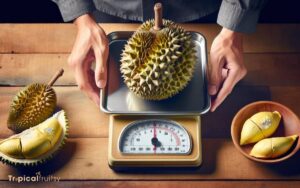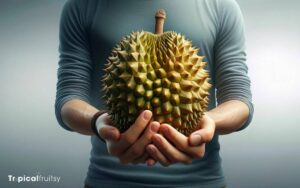What Country Is Durian from? The Origin Unveiled!
Durian, known for its pungent scent and spiky exterior, is indigenous to Southeast Asia. The fruit’s origin is most commonly traced back to the rainforests of Borneo and Sumatra.
Durian is a tropical fruit that is believed to have originated in the regions of Borneo and Sumatra, which are now part of Indonesia and Malaysia.
These countries, along with Thailand, are the main producers of durian and have a deep cultural association with the fruit.
Durian plays a significant role in the agricultural sector of these nations and is cherished for its unique taste and cultural significance.
Durian’s strong presence in Southeast Asia speaks to its cultural resonance and economic value in the region.
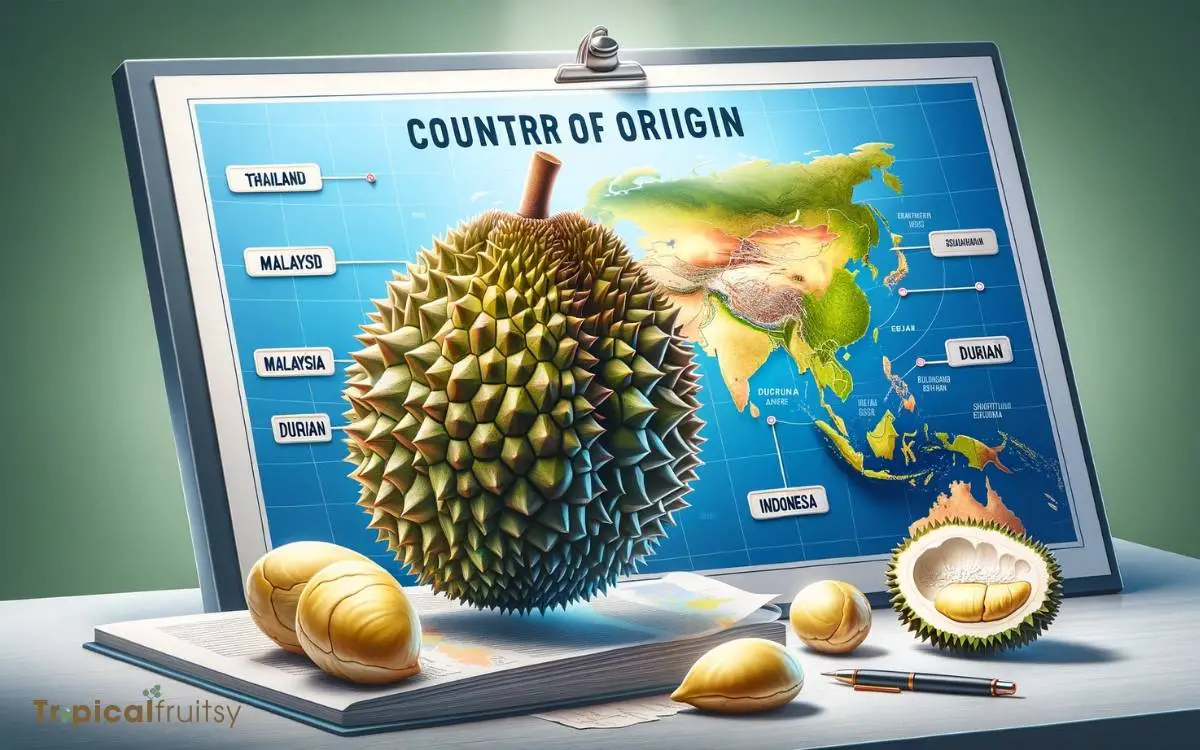
Key Takeaway
Durian Fruit Origins and Leading Producing Countries
| Country | Significance in Durian Production | Known For |
|---|---|---|
| Indonesia | Origin and diversity | Wide variety of durian species |
| Malaysia | Cultivation and quality | Premium durian varieties |
| Thailand | Export and cultivation | Largest durian exporter |
Durian’s Southeast Asian Roots
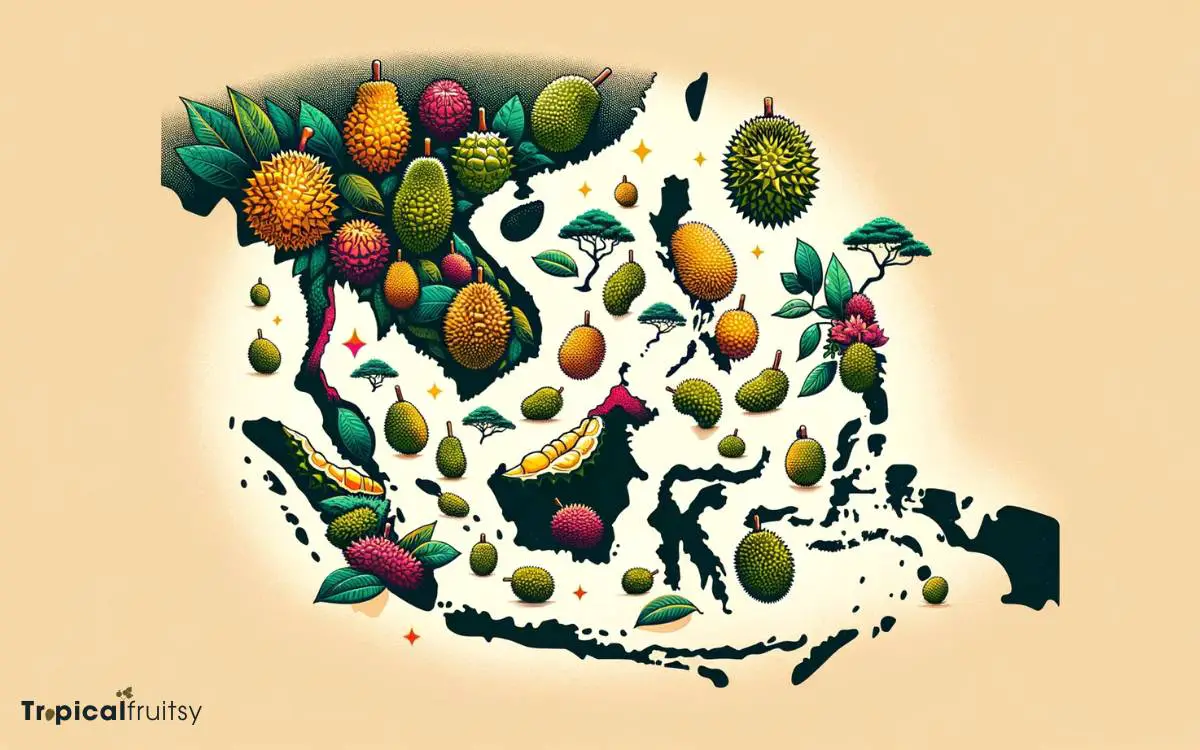
The durian fruit is indigenous to the regions of Borneo and Sumatra in Southeast Asia. Esteemed for its size, unique aroma, and rich custard-like texture, durian is often referred to as the ‘king of fruits.’
Durio zibethinus, the most commercially available species, thrives in the equatorial tropics, where climatic conditions favor its growth.
Botanically, durian belongs to the Malvaceae family, a group that includes other economically significant plants such as cacao and cotton. The cultivation practices and genetic diversity of durian underscore its cultural and ecological standing in the region.
To comprehend its full impact, one must also explore its historical significance, particularly in Indonesia, where durian has long been intertwined with local customs and traditions.
Historical Significance in Indonesia
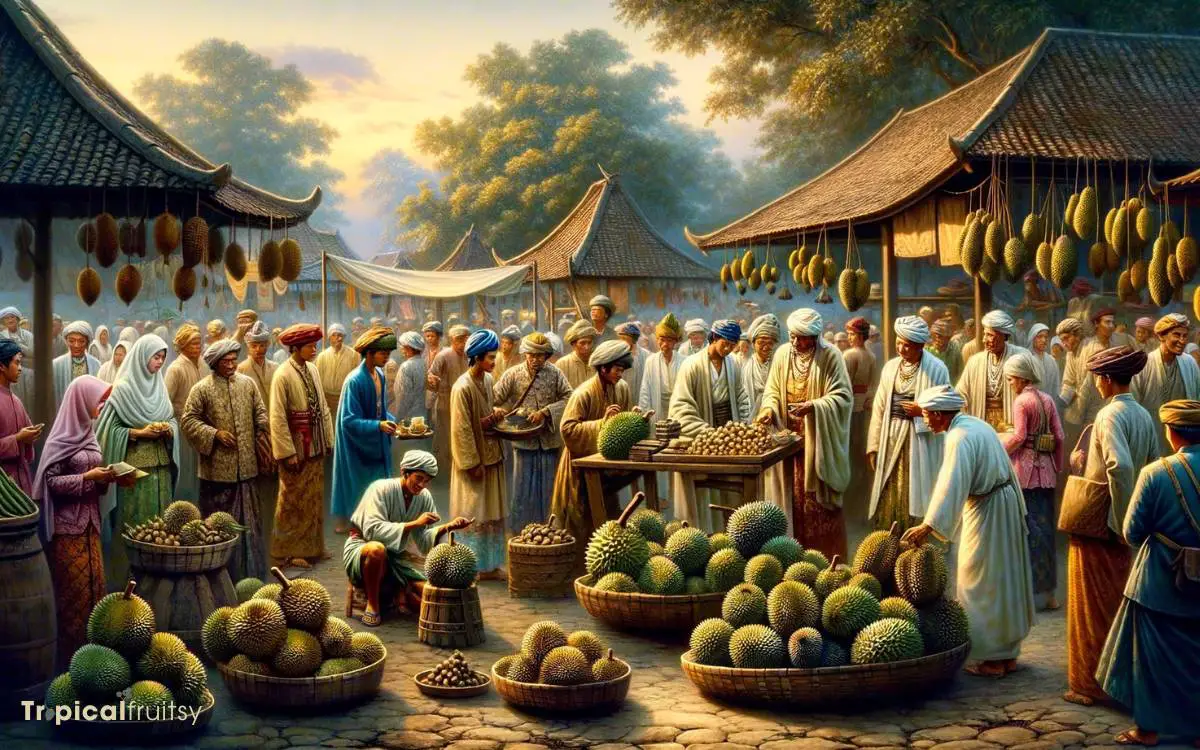
How has durian shaped Indonesia’s historical and cultural landscape?
Durian’s presence in Indonesia is more than a gastronomic affair; it is woven into the cultural fabric and historical identity of the nation. Revered as the ‘king of fruits,’ durian has played a significant role in Indonesian society.
Its cultivation dates back centuries, and over time, it has permeated various aspects of life, from culinary traditions to social practices.
The fruit’s unique and pungent aroma has been a subject of fascination and cultural pride, while its harvest and trade have influenced economic patterns in rural communities.
Durian’s historical significance is also reflected in Indonesian folklore and mythology, symbolizing wealth and prosperity, and it continues to be celebrated in festivals and rituals across the archipelago.
Malaysia’s Durian Diversity
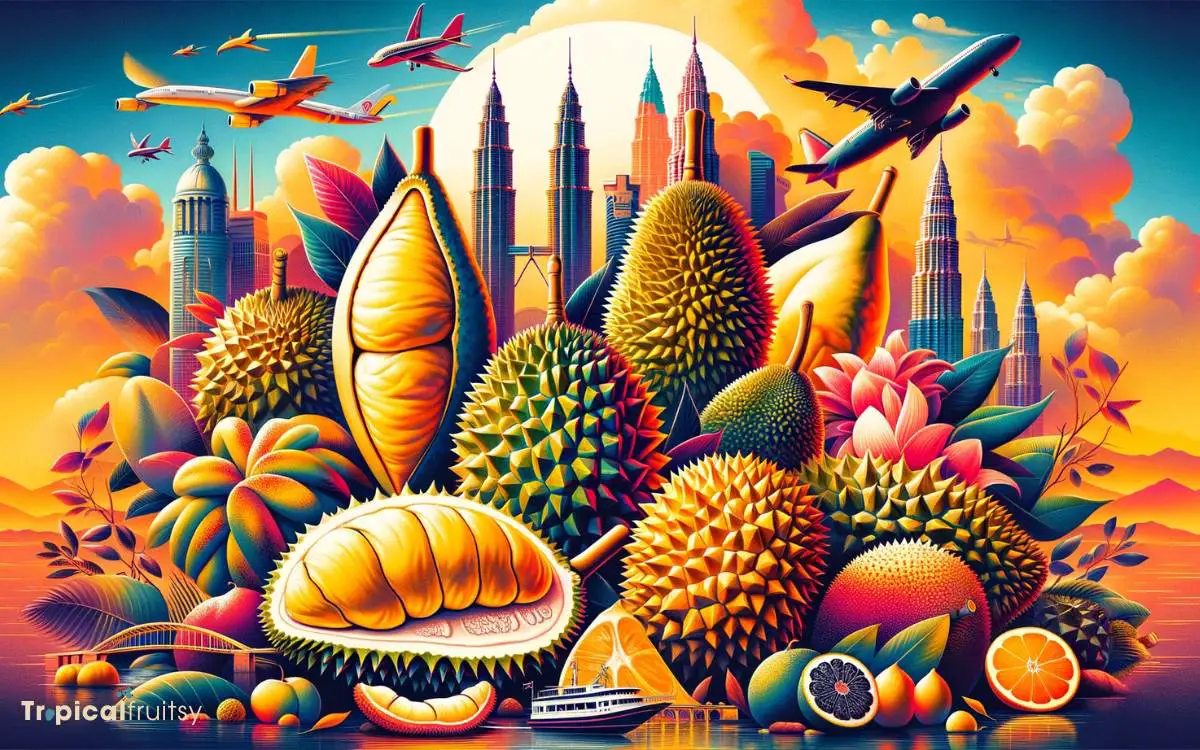
Malaysia boasts over 200 distinct varieties of durian, showcasing a remarkable diversity that underscores the fruit’s cultural and agricultural significance in the country.
These varieties range widely in taste, size, and color, providing a nuanced spectrum of flavors and textures that cater to varying preferences.
Amongst the most esteemed is the Musang King, prized for its creamy texture and deep, complex taste, which sets the benchmark for premium durians.
The D24 Sultan, another popular cultivar, is revered for its bittersweet profile and custard-like consistency.
This diversity is not incidental but the result of meticulous cultivation, cross-breeding, and a deep understanding of terroir that affects the fruit’s characteristics.
Malaysia’s durian diversity is a testament to the nation’s dedication to this unique culinary treasure.
Thailand’s Durian Love Affair
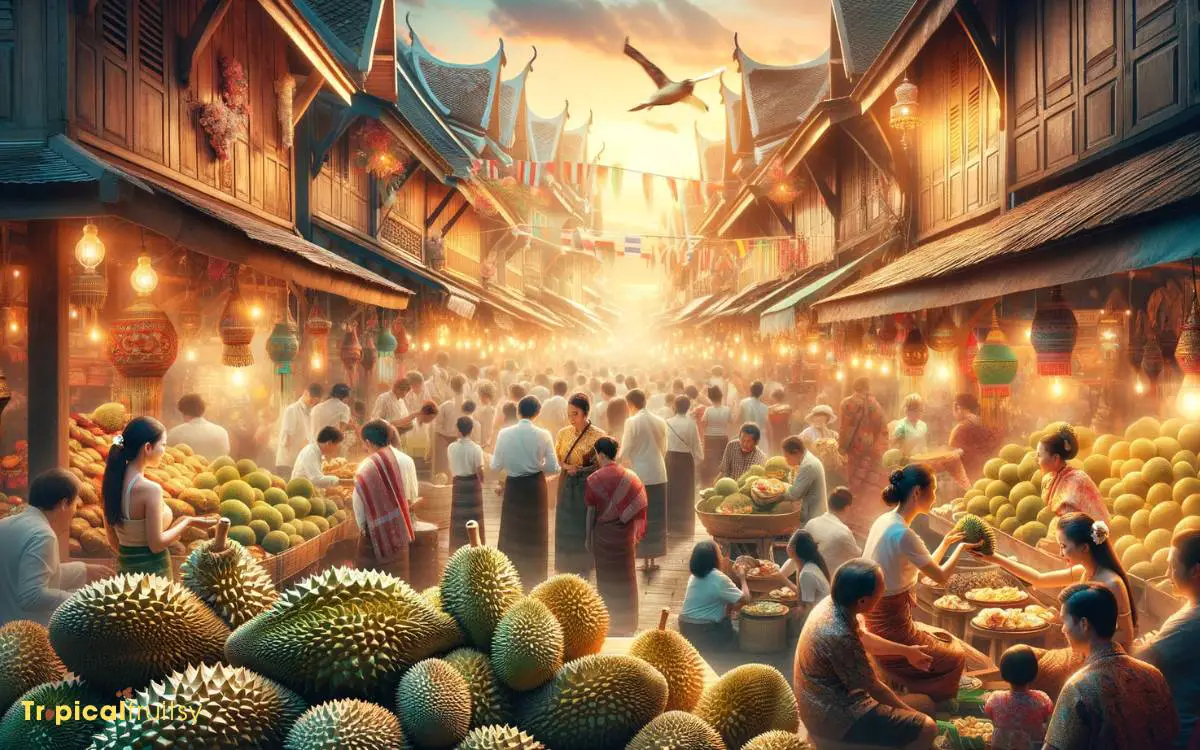
Thailand’s durian fascination is equally robust, with the country not only being a top consumer but also a leading exporter of the so-called ‘King of Fruits’.
The nation has developed a competitive durian industry, characterized by both its volume and the quality of its produce.
Thai farmers have honed their cultivation techniques over generations, optimizing for taste and texture that appeal to both local and international markets.
Durian connoisseurs often debate the merits of Thai durian varieties, such as the sought-after Monthong, compared to those from neighboring countries.
The table below provides an overview of key aspects of Thailand’s durian industry:
| Aspect | Detail | Significance |
|---|---|---|
| Consumption | High domestic demand | Cultural and economic impact |
| Export Volume | One of the world’s largest | Global market influence |
| Varieties | Diverse, including Monthong | Culinary reputation |
Through rigorous agricultural practices and a deep cultural appreciation, Thailand continues to play a pivotal role in the global durian narrative.
Cultivation Practices Across Countries
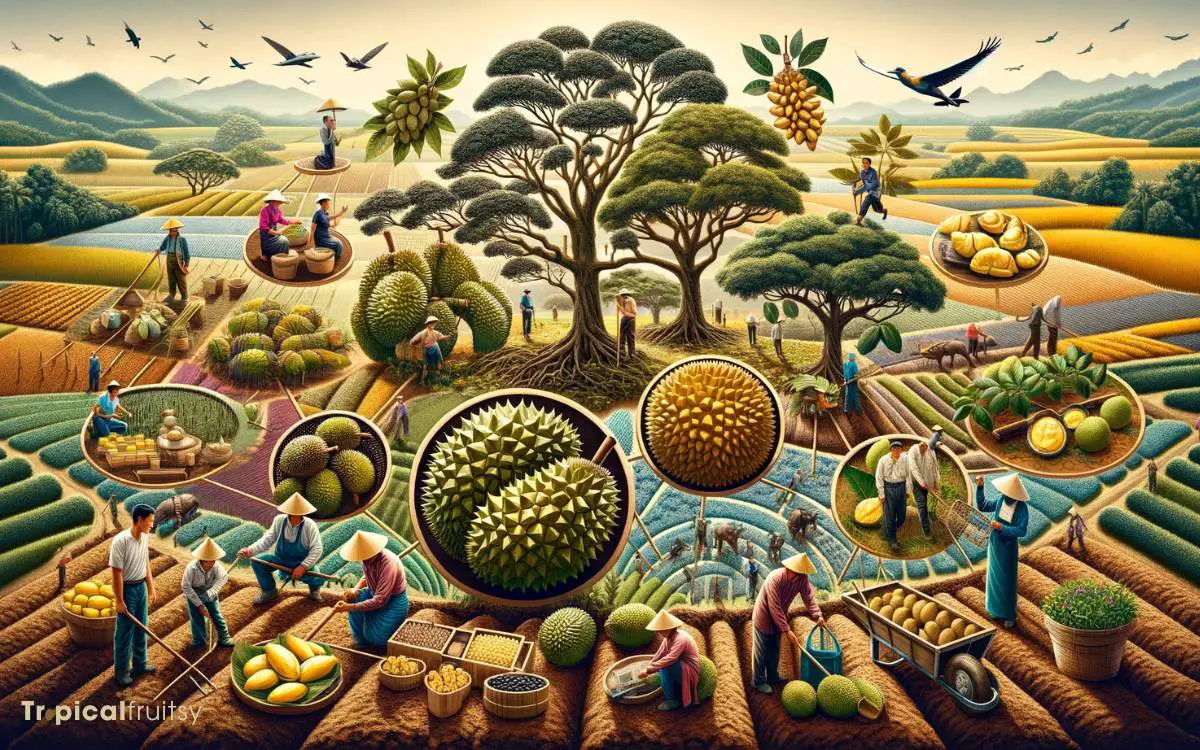
Durian cultivation practices vary across Southeast Asia, reflecting each region’s unique climate, soil conditions, and agricultural heritage.
These practices are deeply rooted in sophisticated agronomic techniques and cultural traditions, contributing to the fruit’s reputation as the ‘King of Fruits.’
To understand the complexity of durian cultivation, one must consider:
- Propagation: Most durians are propagated by grafting to ensure fruit quality consistency.
- Climatic Adaptation: Farmers select durian varieties that are best suited to local weather patterns and temperature ranges.
- Soil Management: Rigorous soil enrichment and irrigation strategies are implemented to meet durian trees’ high nutrient and water demands.
- Pest and Disease Control: Integrated pest management is crucial to protect the sensitive durian crops from infestations and diseases.
These agricultural practices contribute to the distinct characteristics of durian fruit, which segue into the next focus on regional varieties and flavors.
Regional Varieties and Flavors
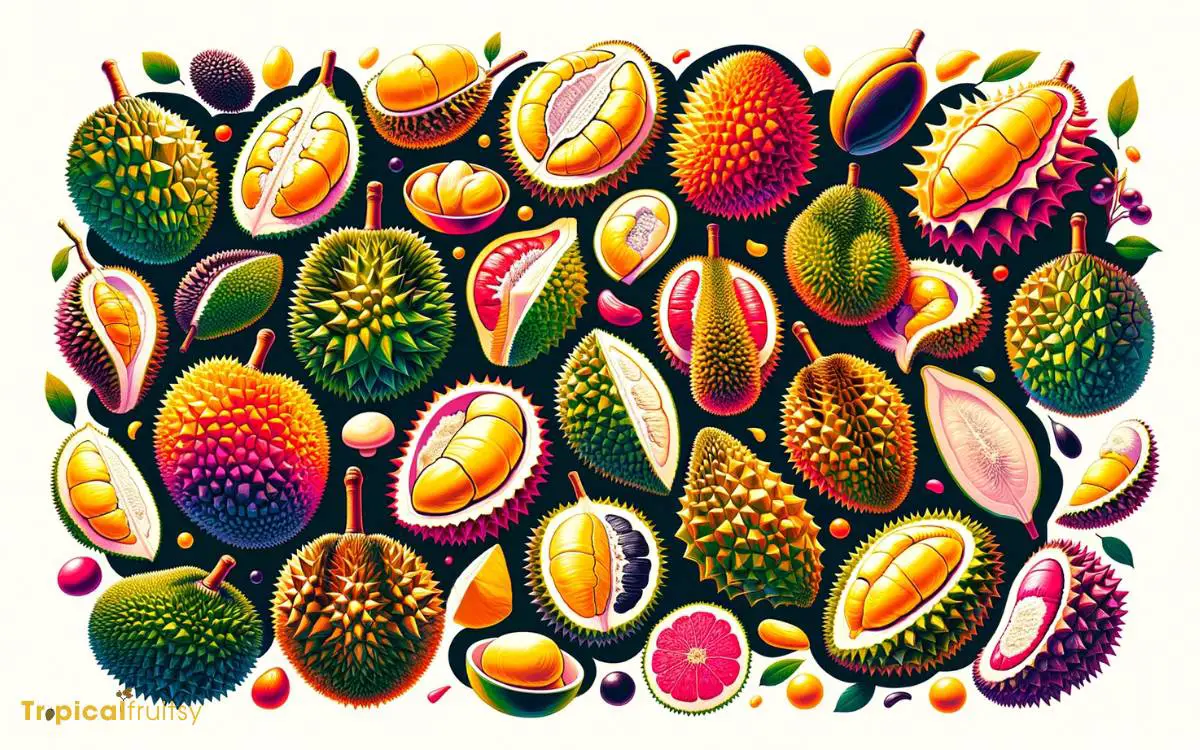
The durian fruit, indigenous to Southeast Asia, exhibits a broad spectrum of flavors and varieties that are profoundly influenced by the region’s diverse climatic and soil conditions.
These regional differences give rise to distinct durian cultivars, each with unique taste profiles ranging from rich and creamy to sweet and subtly bitter.
Scholarly analysis of geographic taste variations is essential to understanding the cultural and agricultural implications of durian cultivation across various countries.
Flavor Diversity
Within the various regions of Southeast Asia, durians exhibit a rich spectrum of flavors and textures, underscoring the fruit’s diversity across its native lands.
The gustatory profile of durians can vary significantly depending on the region, climate, and cultivar, with some varieties being particularly sought after.
The following list encapsulates the variegated nature of durian flavors:
- Thailand: Thai durians often have a sweet, buttery taste with a subtle hint of bitterness, exemplified by the renowned ‘Monthong’ variety.
- Malaysia: Malaysian varieties such as ‘Musang King’ are prized for their rich, creamy texture and complex flavor, with notes of caramel and a potent aroma.
- Indonesia: Indonesian durians can be sweeter and less pungent, with a texture that ranges from custard-like to fibrous.
- Philippines: The durians here are known for their comparatively milder aroma and sweeter flesh, with a less overpowering presence on the palate.
Geographic Taste Differences
Exploring the geographic taste differences, regional varieties of durian in Southeast Asia reveal a delightful array of flavors that cater to a wide range of palates.
In Thailand, cultivars such as ‘Monthong’ are prized for their sweet, custardy taste, while Malaysia’s ‘Musang King’ offers a complex profile with a creamy texture and bittersweet notes.
The Indonesian variety ‘Sukun’ has a firmer flesh and a more subdued sweetness, reflecting the diverse microclimates across the archipelago that contribute to distinct sensory characteristics.
Such nuances are the result of intricate interplays between soil composition, climate, and local cultivation practices.
As we consider these regional taste profiles, we transition to examining how durian is interwoven with local traditions, further influencing its cultural significance and consumption.
Durian in Local Traditions
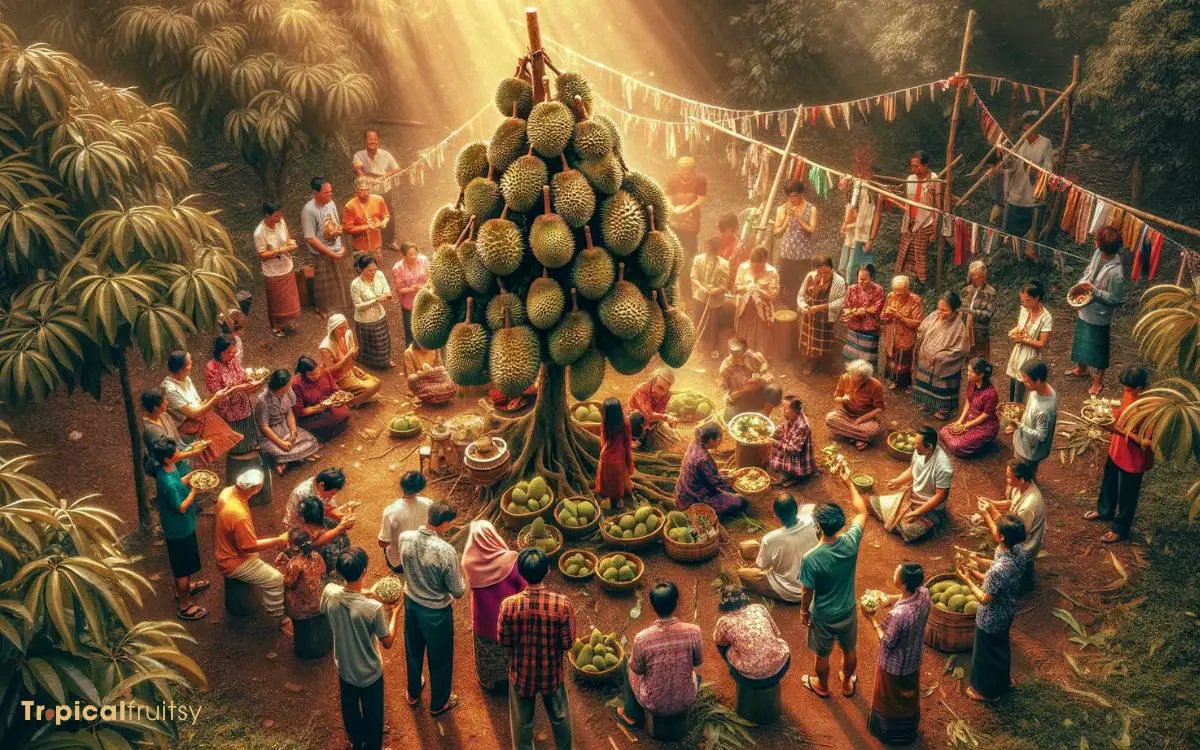
In Southeast Asian cultures, the durian fruit holds a significant place in social and culinary traditions.
Its association with cultural practices can be ascertained by examining the following:
- Ritualistic Offerings: In some communities, durian is used in ritual offerings to deities or spirits, symbolizing abundance and fertility.
- Festive Celebrations: Durian festivals celebrate the season’s harvest, where the fruit’s variety and quality are showcased in competitions and tastings.
- Gastronomic Heritage: Traditional desserts and dishes incorporate durian, displaying its versatility and entrenched role in the region’s cuisine.
- Social Bonding: The shared experience of enjoying or recoiling from durian’s distinctive aroma and taste often serves as a social ritual, forging a sense of community and identity.
These elements reflect the durian’s profound integration into the fabric of local customs and its status as a cultural icon.
The Fruit’s Economic Impact
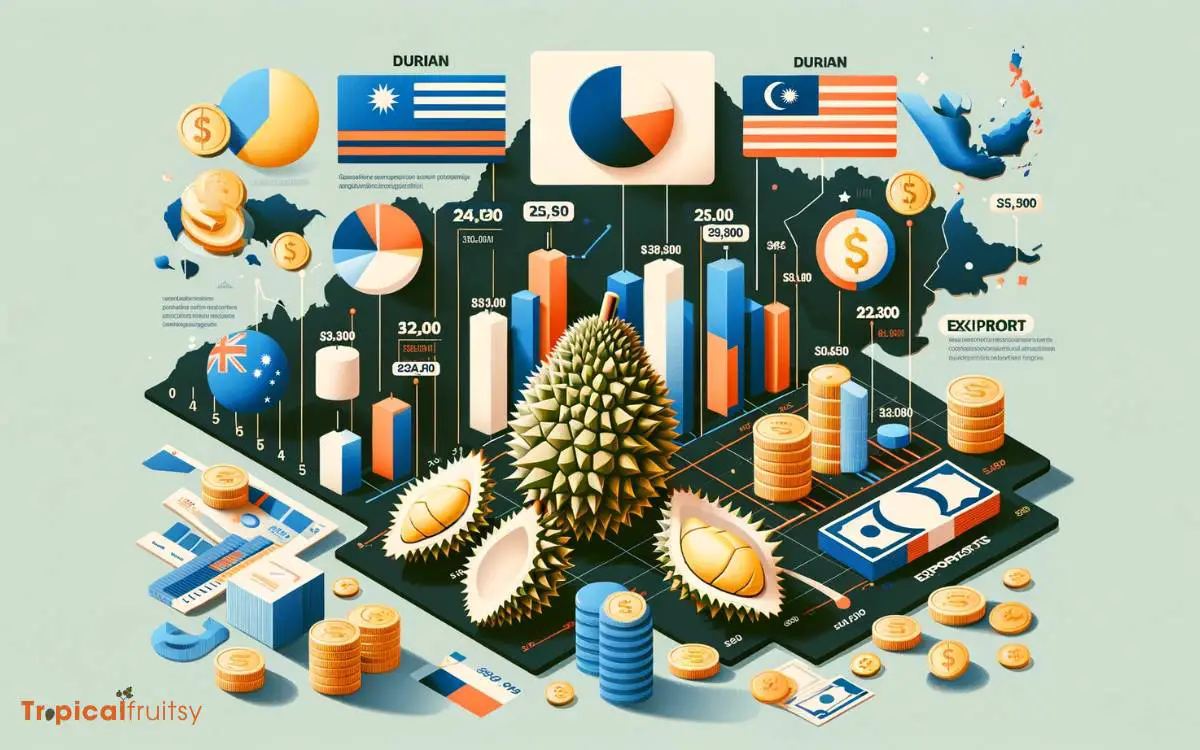
The economic implications of durian cultivation are significant. Export revenue growth represents a major financial boon for producing countries.
The durian industry is a source of agricultural employment. It provides jobs that sustain rural communities and contribute to national labor markets.
Additionally, the fruit’s popularity has a pronounced effect on regional market dynamics. It influences trade balances and agro-economic policies within Southeast Asia.
Export Revenue Growth
Originating from Southeast Asia, durian contributes significantly to the regional economies, particularly through its robust export revenue growth in countries like Thailand and Malaysia.
The economic impact of this fruit is underscored by several key factors:
- Thailand leads the global market, with a substantial portion of its agricultural export income derived from durian, experiencing year-on-year increases.
- Malaysia’s durian export has seen a surge, notably with the premium Musang King variety commanding high prices in international markets.
- China’s appetite for durian has been a major driver of export revenue growth, with the fruit being a coveted item among Chinese consumers.
- Innovations in durian packaging and preservation have facilitated longer shelf life, enabling broader distribution and enhancing export potential.
These elements collectively underscore the lucrative nature of durian in the global fruit market.
Agricultural Job Creation
Several thousand individuals across Southeast Asia secure employment through the durian industry, reinforcing its role as a significant economic catalyst in the agricultural sector.
The cultivation, harvesting, processing, and distribution of durian contribute to a substantial employment framework within the region.
Labor-intensive practices, particularly in the stages of cultivation and harvest, necessitate a considerable workforce.
As the ‘King of Fruits’ commands premium prices, especially in markets like China, the demand for skilled labor in durian orchards ascends correspondingly.
The industry not only creates jobs but also enhances skill sets among agricultural workers, including grafting techniques, pest control, and post-harvest handling.
This upskilling effect can lead to increased productivity, income stability, and socio-economic development in rural communities where economic opportunities are often limited.
Regional Market Influence
Durian, indigenous to Southeast Asia, exerts a significant economic impact on the regional market, shaping trade patterns and influencing agricultural policies.
The fruit’s unique position in the market can be dissected into several critical aspects:
- Export Revenue: Countries like Thailand, Malaysia, and Indonesia generate substantial income from exporting durian to China and other markets.
- Price Fluctuations: Durian’s seasonal nature leads to price volatility, affecting farmer incomes and market stability.
- Agricultural Investment: The high demand for premium durian cultivars spurs investment in cultivation techniques and infrastructure.
- Cultural Significance: Its cultural importance can dictate market demand, with festivities and traditions often increasing consumption rates.
The economic fabric woven by the durian trade is thus both intricate and robust. This significance extends beyond the market, influencing cultural spheres through durian festivals and tourism, which further bolsters regional economies.
Durian Festivals and Tourism
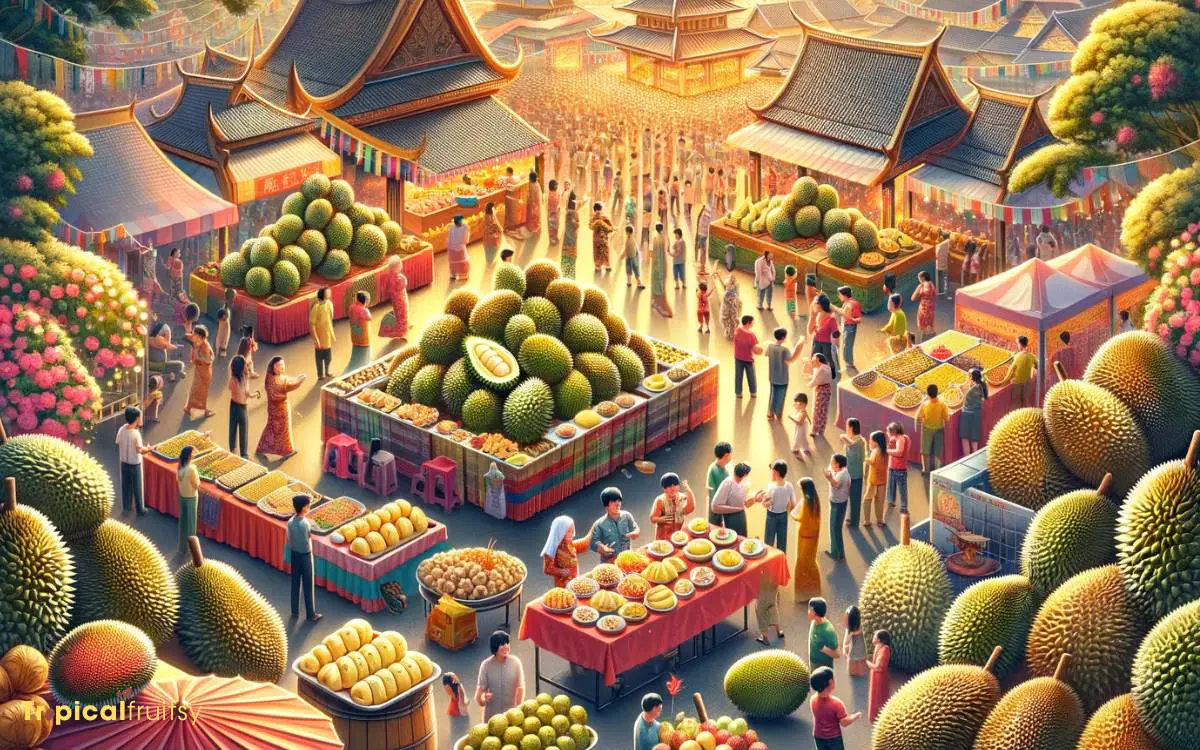
While the durian is native to several Southeast Asian countries, it is the centerpiece of numerous festivals that attract both local and international tourists seeking to experience its unique taste and cultural significance.
These festivals not only celebrate the durian fruit itself but also the agricultural traditions surrounding its cultivation and harvest.
Visitors are offered an array of durian varieties, each with distinct flavors and textures, amidst a vibrant atmosphere of cultural performances and local crafts.
Agricultural tours often accompany these events, providing an educational dimension that explores the ecological nuances and farming techniques essential to durian production.
The symbiotic relationship between such festivals and tourism fosters economic growth in rural areas, while simultaneously preserving and promoting the diverse cultural heritage associated with this iconic fruit.
Conclusion
In the tapestry of Southeast Asian culture, the durian stands as a formidable symbol of both economic vitality and cultural heritage.
Like the complex layers of a traditional batik, each region weaves its own narrative with this pungent fruit, contributing to a rich pattern of diversity and tradition.
The durian’s journey from indigenous treasure to global delicacy underscores its role in shaping the socioeconomic landscapes of its native lands, echoing the enduring spirit of Southeast Asia itself.

